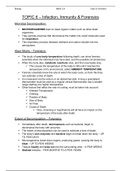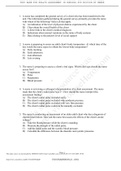Biology Nikhil 13Y Topic 6 Full Notes
TOPIC 6 – Infection, Immunity & Forensics
Microbial Decomposition:
MICROORGANISMS feed on dead organic matter such as other dead
organisms.
They secrete enzymes that decompose the matter into small molecules used
for respiration.
This respiratory process releases methane and carbon dioxide into the
atmosphere.
Algor Mortis – Forensics:
The study of core body temperature following death, can show forensic
scientists when the individual may have died, and the possible circumstances.
When the body dies, metabolic reactions slow, and then eventually stop.
This causes the temperature of the body to fall until it reaches the
temperature of it’s environment, called AMBIENT TEMPERATURE.
Forensic scientists know the rate at which the body cools, so from this they
can estimate a time of death.
It is measured via the rectum or an abdominal stab. A long a specialised
thermometer must be used as a regular clinical thermometer has a smaller
range starting at a higher temperature.
Other factors that affect the rate of cooling, must be taken into account:
Ambient Temperature
Clothing
Position of Body
Size of Body
Air Flow
Cause of Death
Fires, drowning or hypothermia will all have an impact on the
temperature of the body after death.
Extent of Decomposition – Forensics:
Immediately after death, decomposers such as bacteria, begin to
decompose the body with enzymes.
The extent of decomposition can be used to estimate a time of death.
The body’s own enzymes and bacteria begin to break down the body – UP
TO FEW DAYS
Microorganisms break down organs, producing gases, causing the body to
bloat – UP TO FEW WEEKS
Tissues liquefy and seep out into the surrounding area – A FEW WEEKS
Skeletal remains – FEW MONTHS TO A FEW YEARS
, Biology Nikhil 13Y Topic 6 Full Notes
Rigor Mortis – Forensics:
This refers to the phenomenon after death whereby muscles contract and
eventually become stiff.
This occurs around 4 to 6 hours after death.
Smaller muscles contract first, and then larger ones. By 12 to 18 hours, all
muscles will have contracted.
The process is a result of ANAEROBIC RESPIRATION.
Respiration halts after death, and muscles are deprived of oxygen.
However respiration still occurs in muscle cells, with the absence of
oxygen. This produces LACTIC ACID.
The pH of the cells falls, becoming more acidic.
This inhibits enzymes that produce ATP.
As a result, there is no ATP production, and the bonds between
MYOSIN and ACTIN in muscle cells become FIXED & muscles stiffen.
Rigor passes as the muscles begin to decay.
Other factors can affect the rate of rigor mortis:
AMBIENT TEMPERATURE
Rigor mortis will set in quicker and last shorter, if the
temperature is higher.
ACTIVITY BEFORE DEATH
Rigor mortis will set in quicker and last shorter, if the individual
was more active before death, as respiration rate is higher.
Forensic Entomology:
When an individual dies, the body is rapidly colonised by a range of
organisms.
The study of this is called forensic entomology.
The time of death can be estimated by observing the insect on the body.
The first to appear are eggs which hatch into larvae.
Forensic scientists take ‘maggot mass’ samples of dead maggots at the time,
and then culture the maggots into adults to determine the time for a complete
life cycle, but also to determine the species when they pupate.
The metamorphic life cycle of a fly is used with First, Second & Third Instar
larvae, and a pupa.
From this entomologist can deduce when eggs were laid, and therefore
the time of death.
Some factors such as toxins like cocaine, can accelerate insect
developments.
Other insects then are attracted to the prey on the corpse, and so more
insects can appear on the body.
SUCCESSION can occur on the corpse.
When one group of organisms feed on the corpse due to their
attraction to it, they CHANGE THE CONDITIONS to make it attractive
to other organisms.
However unlike in plant succession, where species are REPLACED
by successive species, most of the early insects remain on the body
until the advanced stage of decay, so insect numbers continue to
increase.














